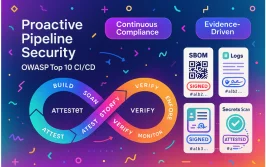TL;DR — A self-replicating npm “worm” dubbed Shai-Hulud poisoned popular packages, stole developer/CI secrets, and then used those secrets to publish more malicious versions, turning victims into new propagation points. Within hours of the disclosures, Scribe ran portfolio-wide checks across our customers’ SBOMs and build attestations and confirmed their pipelines were not pulling any compromised versions. We also have a policy guardrail to block any late-arriving variants.
What happened
Beginning Sept 15–17, researchers reported a large-scale supply-chain compromise in the npm ecosystem. The campaign weaponized new releases of legitimate packages and dropped a multi-stage payload that:
- Exfiltrated secrets (npm/GitHub tokens, cloud creds, API keys), sometimes by invoking popular secret-scanning tools;
- Self-propagated by abusing stolen publishing rights to push new malicious versions from impacted maintainers.
- In many cases, published stolen data to GitHub (e.g., repos named “Shai-Hulud” and “Shai-Hulud Migration”) and even made some private repos public.
Early tallies ranged from 150–200+ packages and hundreds of malicious versions, with several maintainers affected—including some packages under well-known vendor namespaces. Notably, the wave touched ecosystems used by Angular developers (e.g., ngx-bootstrap, ng2-file-upload) and the popular @ctrl/tinycolor library.
Why this attack is different:
- It’s worm-like: once a developer or CI pulls an infected version, the payload attempts to harvest credentials and publish more infected packages, snowballing blast radius without constant human direction.
- The goal isn’t just code execution, it’s sustained publisher compromise and ecosystem-level spread, which makes “point-in-time” cleanup insufficient.
Likely consequences
- Credential exposure & lateral movement. Exfiltrated tokens may enable publishing backdoors, repo tampering, and CI/CD persistence even after packages are yanked.
- Silent dependency poisoning. Popular packages update frequently; a single npm install or CI build can import malicious post-install scripts at scale.
- Public leakage of private IP. Some victims saw private repos forced public during propagation, expanding legal and reputational risk.
How Scribe helped customers respond immediately
Within hours of the first reliable reports, Scribe initiated a two-fold verification and containment playbook across customer environments:
- SBOM & Dependency Graph Sweep
- Queried continuously generated SBOMs and lockfiles across repos, images, and functions to locate any referenced malicious package names/versions tied to Shai-Hulud disclosures (e.g., @ctrl/tinycolor variants; affected Angular packages).
- Result: for our managed portfolios, no active pipelines or artifacts were consuming flagged versions; customers were notified the same night with evidence.
- Policy-as-Code Guardrails & Gating
- Temporarily pinned critical packages, blocked unsigned or unvetted updates, and enforced gates that alert when detections matched IoCs (names/versions, publish windows, Indicators from research teams).
- For teams using our agentic workflows, auto-remediation proposed clean version bumps and created PRs with provenance proofs attached for one-click review.
Why this worked
- Continuous evidence beats periodic audits. Because Scribe continuously collects SBOMs, scanner outputs, and build attestations, we could answer “Were we exposed?” with immediate, portfolio-wide facts, not best-effort guesses.
- Guardrails stop the spread. Even if a developer ran npm update locally, Scribe’s pre-prod gates can prevent tainted artifacts from graduating to integration, staging, or prod.
- Agentic response closes MTTR. Our remediation agents draft PRs (pin, revert, or upgrade), rotate CI secrets where required, and document the chain-of-custody—turning a scramble into a checklist.
If you’re assessing your exposure today
- Inventory first. Search SBOMs/lockfiles and artifact manifests for affected package names/versions published in the incident window. (Multiple vendors have running tallies and IoCs.)
- Rotate tokens issued from any machine or runner that executed an infected package. Assume lateral movement; rebuild from trusted builders.
- Review GitHub audit logs for repos named “Shai-Hulud” or “Shai-Hulud Migration,” deleted branches, or forced public migrations.
- Harden your pipeline: enforce signature/provenance verification, pin critical libs, and gate on policy failures (e.g., unsigned/unknown publisher, anomalous post-install scripts).
The bigger picture
Shai-Hulud is a preview of where supply-chain threats are headed: credential-stealing, self-propagating malware that weaponizes the developer ecosystem itself. The answer isn’t heroic incident response; it’s continuous assurance—signed evidence, verifiable provenance, policy-as-code, and automated, agentic remediation that runs at developer speed.
If you want help validating exposure or standing up guardrails & gating that would have blocked this class of attack, we’re happy to walk your team through a tailored assessment using your own pipelines and SBOMs.
For more details, contact us
This content is brought to you by Scribe Security, a leading end-to-end software supply chain security solution provider – delivering state-of-the-art security to code artifacts and code development and delivery processes throughout the software supply chains. Learn more.



